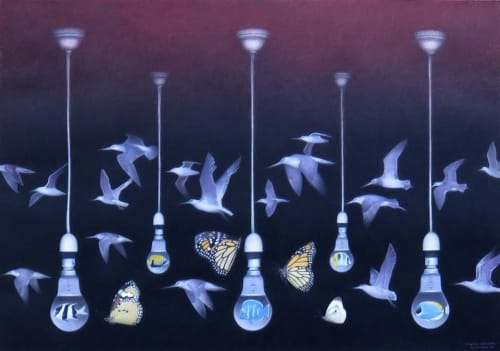A delicate balance of light and shadow births a surreal logic, where jars cradle flight and bulbs harbor currents. Figures and forms dissolve into symbols, inviting us to dream beyond the edge of reason.
An abiding interest in the surreal and the symbolic has seen Paul Martinson shift away from realism in search of a style that expresses the poetry of the human mind. While retaining a drawing-based figurative style, Martinson has embraced a personal, liberal approach to painting that allows a free flow of imagery and ideas.
Martinson’s compositions are surreal and poetic; a bird in flight within a closed glass jar, a fish swimming in a water-filled light bulb. Where human figures appear, they are rendered as archetypal forms—faceless, marble-skinned Venus figures in sensuous, surreal contexts. Given the prevalence of symbolism in these works, it is no surprise that Freudian psychoanalysis and the Surrealist notion of Psychic Automatism form the basis of his artistic philosophy. In the absence of reason, Martinson is free to work without the censure of his conscious mind.
The movement towards the symbolic has seen Martinson extend his painting technique in new ways, emphasising the emotional properties of colour and light as well as formal composition. The unparalleled attention to representational detail remains obvious in his depictions of birds and other animals and the textural range of his paintings creates a rich, lifelike effect. In new works such as Jam Jar Journey, however, we see colour treated in a symbolic manner, with the deep green and black tones used for emotional effect rather than for their realism.
Recent works have demonstrated Martinson’s continuing experimentation with new media and materials, which has afforded him more opportunities to experiment with scale, composition and style. The use of watercolour paint allows the creation of rich, evocative backgrounds and expressive variations of colour density. The use of aluminium and wood as media also creates a deeper variety of tonal and textural qualities throughout his work.
A key aspect of Martinson’s practice is his realisation of the importance of light as a symbolic element, as well as one of his primary tools for the creation of the Gothic mood of many of his paintings. As his works become increasingly symbolic, they also demonstrate a greater subtlety in terms of colour and tone, as well as a mastery over the complexities of light.
Each of these formal developments has assisted Martinson’s exploration of universal conditions and anxieties. The tensions between real and imagined, human and animal, light and dark, are borne out in his works, which address notions of agency and power and evoke various psychological states. This encourages a deeper engagement with the work as the reader is invited to speculate on the intellectual or conceptual theme of the work while instinctively connecting with it on an emotional level.

